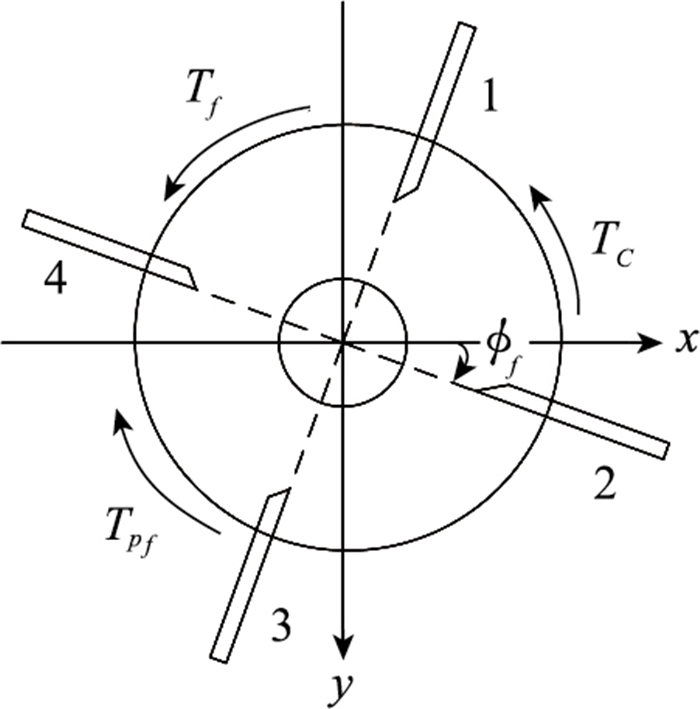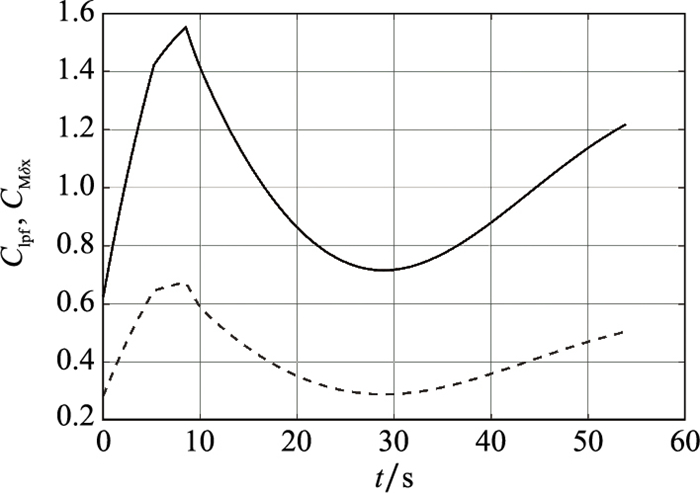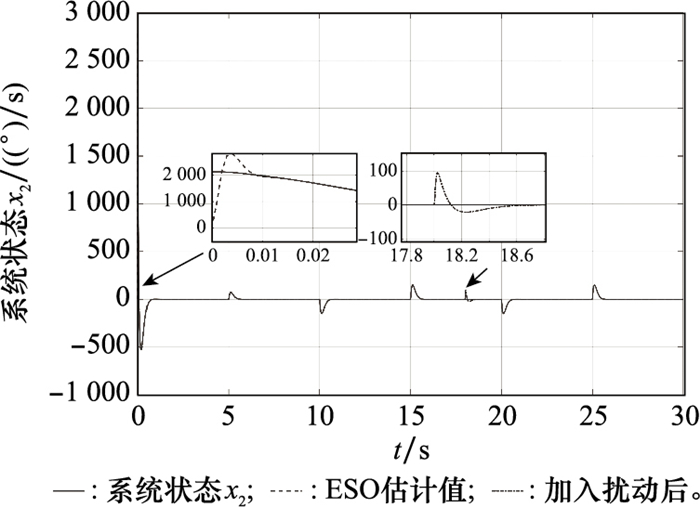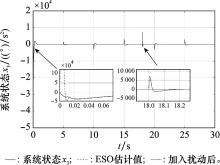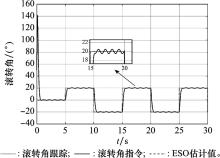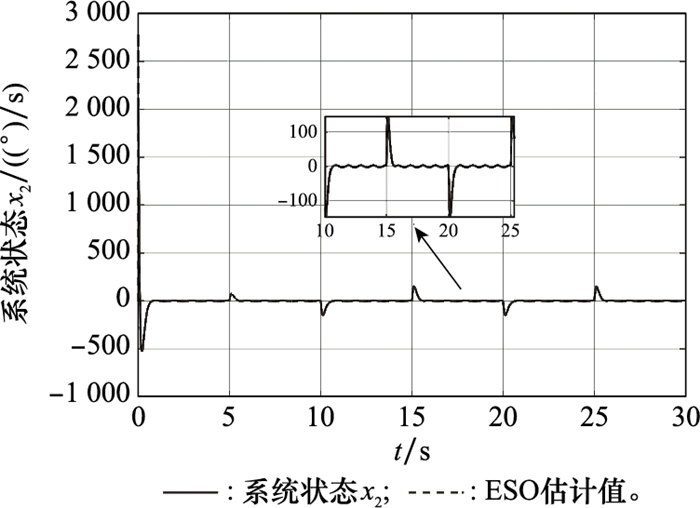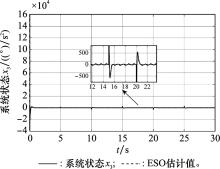Systems Engineering and Electronics ›› 2024, Vol. 46 ›› Issue (4): 1412-1421.doi: 10.12305/j.issn.1001-506X.2024.04.30
• Guidance, Navigation and Control • Previous Articles Next Articles
Research on roll control technology of trajectory correction fuse with active-canards
Qiushi ZHENG1,*, Weichun XU2, Minghan ZHAO1, Naixing LI1, Xuxin BAO1
- 1. Shanghai Radio Equipment Research Institute, Shanghai 201109, China
2. Shanghai Academy of Spaceflight Technology, Shanghai 201109, China
-
Received:2023-05-11Online:2024-03-25Published:2024-03-25 -
Contact:Qiushi ZHENG
CLC Number:
Cite this article
Qiushi ZHENG, Weichun XU, Minghan ZHAO, Naixing LI, Xuxin BAO. Research on roll control technology of trajectory correction fuse with active-canards[J]. Systems Engineering and Electronics, 2024, 46(4): 1412-1421.
share this article
| 1 |
REGAN F J , SMITH J .Aeroballistics of a terminally corrected spinning projectile (TCSP)[J].Journal of Spacecraft and Rockets,1975,12(12):733-738.
doi: 10.2514/3.57041 |
| 2 | 王中原, 史金光, 常思江, 等.弹道修正弹技术发展综述[J].弹道学报,2021,33(2):1-12. |
| WANG Z Y , SHI J G , CHANG S J , et al.Review on development of technology of trajectory correction projectile[J].Journal of Ballistics,2021,33(2):1-12. | |
| 3 | 邢炳楠, 杜忠华, 杜成鑫.二维弹道修正弹及其制导控制技术综述[J].国防科技大学学报,2021,43(4):53-68. |
| XING B N , DU Z H , DU C X .Review on two-dimensional tra- jectory correction projectile and its guidance and control technology[J].Journal of National University of Defense Technology,2021,43(4):53-68. | |
| 4 | PARK W, RYOO C K, KIM Y, et al. A new practical guidance law for a guided projectile[C]//Proc. of the AIAA Guidance, Navigation, and Control Conference, 2011. |
| 5 |
TIPAN S , THEODOULIS S , THAI S , et al.Nonlinear dynamic inversion flight control design for guided projectiles[J].Journal of Guidance, Control, and Dynamics,2020,43(12):1-6.
doi: 10.2514/1.G002893.c1 |
| 6 | GAGNON E, LAUZON M. Course correction fuze concept analysis for in-service 155 mm spin-stabilized gunnery projectiles[C]// Proc. of the AIAA Guidance, Navigation & Control Conference & Exhibit, 2013. |
| 7 | 柯知非, 宋卫东.二维弹道修正组件发展现状及关键技术[J].飞航导弹,2018,(5):81-85. |
| KE Z F , SONG W D .Development status and key technologies of two-dimensional trajectory correction projectiles[J].Aerodynamic Missile Journal,2018,(5):81-85. | |
| 8 | 程杰, 于纪言, 王晓鸣, 等.隔转鸭舵式弹道修正弹电磁执行机构工况研究[J].兵工学报,2014,35(12):2010-2015. |
| CHENG J , YU J Y , WANG X M , et al.Research on working condition of electromagnetic actuator of trajectory correction projectile with decoupled canards[J].Acta Armamentarii,2004,35(12):2010-2015. | |
| 9 |
程杰, 王晓鸣, 于纪言, 等.隔转鸭舵式弹道修正弹双旋通道参数辨识[J].兵工学报,2016,37(10):1812-1819.
doi: 10.3969/j.issn.1000-1093.2016.10.007 |
|
CHENG J , WANG X M , YU J Y , et al.Parameter estimation of axial dual-spin system in a trajectory correction projectile with decoupled canards[J].Acta Armamentarii,2016,37(10):1812-1819.
doi: 10.3969/j.issn.1000-1093.2016.10.007 |
|
| 10 | 殷婷婷, 贾方秀, 于纪言, 等.双旋弹丸弹道修正组件控制响应模型研究[J].北京理工大学学报,2018,38(2):183-189. |
| YIN T T , JIA F X , YU J Y , et al.Roll control response model of the dual-spin trajectory correction component[J].Transactions of Beijing Institute of Technology,2018,38(2):183-189. | |
| 11 | 殷婷婷, 贾方秀, 于纪言, 等.基于扩张状态观测器的双旋弹丸舵翼转速预测控制[J].北京理工大学学报,2019,39(10):1057-1062, 1068. |
| YIN T T , JIA F X , YU J Y , et al.Direct model predictive rotating speed control for rudder in dual-spin projectile with output-feedback extended state observer[J].Transactions of Beijing Institute of Technology,2019,39(10):1057-1062, 1068. | |
| 12 | 张鑫, 姚晓先.固定翼双旋弹修正组件滚转控制研究[J].北京理工大学学报,2020,40(4):386-395. |
| ZHANG X , YAO X X .Roll control of course correction fuze for dual-spin projectile with fixed-canards[J].Transactions of Beijing Institute of Technology,2020,40(4):386-395. | |
| 13 | ILG M D. Guidance, navigation, and control for munitions[D]. Philadelphia: Drexel University, 2008. |
| 14 | 朱大林. 双旋弹飞行特性与制导控制方法研究[D]. 北京: 北京理工大学, 2015. |
| ZHU D L. Research on flight characteristics, guidance, and control for a dual-spin projectile[D]. Beijing: Beijing Institute of Technology, 2015. | |
| 15 |
ZHU D L , TANG S J , GUO J , et al.Flight stability of a dual-spin projectile with canards[J].Proceedings of the Institution of Mechanical Engineers, Part G: Journal of Aerospace Engineering,2015,229(4):703-716.
doi: 10.1177/0954410014539293 |
| 16 | THEODOULIS S, GASSMAN V, BRUNNER T, et al. Robust bank-to-turn autopilot design for a class of 155 mm spin-stabilized canard-guided projectiles[C]//Proc. of the AIAA Atmospheric Flight Mechanics Conference, 2013. |
| 17 | SALMAN M U, CHANG B, ILG M D. Control of spinning flying vehicles utilizing partial body despin techniques[C]//Proc. of the 7th Asian Control Conference, 2009. |
| 18 | THEODOULIS S, GASSMAN V, BRUNNER T, et al. Fixed structure robust control design for the 155 mm canard-guided projectile roll-channel autopilot[C]//Proc. of the 21st Mediterranean Conference on Control & Automation Platanias-Chania, 2013. |
| 19 | 刘金琨.滑模变结构控制MATLAB仿真[M].北京: 清华大学出版社,2019. |
| LIU J K .Sliding mode control design and MATLAB simulation[M].Beijing: Tsinghua University Press,2019. | |
| 20 |
刘金琨, 孙富春.滑模变结构控制理论及其算法研究进展[J].控制理论与应用,2007,24(3):407-418.
doi: 10.3969/j.issn.1000-8152.2007.03.015 |
|
LIU J K , SUN F C .Research and development on theory and algorithms of sliding mode control[J].Control Theory & Applications,2007,24(3):407-418.
doi: 10.3969/j.issn.1000-8152.2007.03.015 |
|
| 21 |
UTKIN V I .Variable structure systems with sliding modes[J].IEEE Trans.on Automatic Control,1977,22(2):212-222.
doi: 10.1109/TAC.1977.1101446 |
| 22 |
YU X , KAYNAK O .Sliding-mode control with soft computing: a survey[J].IEEE Trans.on Industrial Electronics,2009,56(9):3275-3285.
doi: 10.1109/TIE.2009.2027531 |
| 23 |
LIU L , DING S H , YU X H .Second-order sliding mode control design subject to an asymmetric output constraint[J].IEEE Trans.on Circuits and Systems Ⅱ-Express Briefs,2021,68(4):1278-1282.
doi: 10.1109/TCSII.2020.3021715 |
| 24 |
LAGHROUCHE S , HARMOUCHE M , CHITOUR Y , et al.Barrier function-based adaptive higher order sliding mode controllers[J].Automatica,2021,123,109355.
doi: 10.1016/j.automatica.2020.109355 |
| 25 | 韩京清.一类不确定对象的扩张状态观测器[J].控制与决策,1995,10(1):85-88. |
| HAN J Q .Extended state observer for a class of uncertain plants[J].Control and Decision,1995,10(1):85-88. | |
| 26 | HAN J Q , HUANG Y .Analysis and design for the second order nonlinear continuous extended states observer[J].Chinese Science Bulletin,2000,21(3):1938-1944. |
| 27 |
LIU C Q , LUO G Z , DUAN X L , et al.Adaptive LADRC-based disturbance rejection method for electromechanical servo system[J].IEEE Trans.on Industry Applications,2020,56(1):876-889.
doi: 10.1109/TIA.2019.2955664 |
| 28 |
LIU C Q , LUO G Z , CHEN Z , et al.Measurement delay compensated LADRC based current controller design for PMSM drives with a simple parameter tuning method[J].ISA Transactions,2020,101,482-492.
doi: 10.1016/j.isatra.2020.01.027 |
| 29 |
LU W Q , TANG B , JI K H , et al.A new load adaptive identification method based on an improved sliding mode observer for PMSM position servo system[J].IEEE Trans.on Power Electronics,2021,36(3):3211-3223.
doi: 10.1109/TPEL.2020.3016713 |
| 30 | WANG W W, GAO Z Q. A comparison study of advanced state observer design techniques[C]//Proc. of the American Control Conference, 2003. |
| 31 | IOANNOU P A , SUN J .Robust adaptive control[M].Upper Saddle River: PTR Prentice-Hall,1996. |
| [1] | Yang GUI, Bochao ZHENG, Peng GAO. Sliding mode attitude control of quadrotor UAV based on NESO-LFDC [J]. Systems Engineering and Electronics, 2024, 46(3): 1075-1083. |
| [2] | Yushi JIANG, Yang CHEN, Lu GAO, Ligen CAI, Jixing LYU. Predefined-time adaptive control for heavy-lift launch vehicles [J]. Systems Engineering and Electronics, 2023, 45(8): 2570-2577. |
| [3] | Haoran LU, Wei ZHENG, Xiaohua CHANG. Fractional order sliding mode guidance law based on robust exact differentiator [J]. Systems Engineering and Electronics, 2023, 45(1): 175-183. |
| [4] | Shibin LUO, Xiaodong LI, Zhongsen WANG, Cheng XU. Generalized super-twisting finite-time control for the ascent phase of parallel carrier [J]. Systems Engineering and Electronics, 2022, 44(5): 1626-1635. |
| [5] | Xiao TANG, Jikun YE, Xu LI. Design of 3D nonlinear prescribed performance guidance law [J]. Systems Engineering and Electronics, 2022, 44(2): 619-627. |
| [6] | Wenqi YANG, Jianhua LU, Xu JIANG, Yuanxin WANG. Design of quadrotor attitude active disturbance rejection controller based on improved ESO [J]. Systems Engineering and Electronics, 2022, 44(12): 3792-3799. |
| [7] | Zhongxing GAO, Bin PENG, Xiaowei CHEN, Yonggang ZHANG. Discrete sliding mode control for ellipse parameters of vibrating gyroscope [J]. Systems Engineering and Electronics, 2022, 44(1): 226-232. |
| [8] | Yuekun ZHANG, Xiaohong JIA, Xiaoyang ZHANG, Weiqiang WANG. Integrated design of detection guidance and control based on finite time disturbance observer [J]. Systems Engineering and Electronics, 2021, 43(5): 1326-1334. |
| [9] | Jiahui GUO, Binan JIANG, Zonghao TIAN. Guidance law design of guided projectile with impact angle and field-of-view constraints [J]. Systems Engineering and Electronics, 2021, 43(4): 1050-1056. |
| [10] | Shiyan SUN, Shang JIANG, Fuqing TIAN, Weige LIANG. Distributed adaptive cooperative guidance law of multiple projectiles with multiple constraints [J]. Systems Engineering and Electronics, 2021, 43(1): 181-190. |
| [11] | Xun GONG, Yunbo FU, Liangxu JIANG, Ce CAO, Tongjian GUO. Application of super-twisting extended state observer in fault reconfiguration of quadrotor aircraft [J]. Systems Engineering and Electronics, 2020, 42(9): 2077-2084. |
| [12] | Yan DING, Zhigang YU. Adaptive sliding mode fault tolerant control of UAV considering input and output constraints [J]. Systems Engineering and Electronics, 2020, 42(10): 2340-2347. |
| [13] | DENG Yingjie, ZHANG Xianku, ZHANG Guoqing. Dynamic positioning system of marine surface vessel with ESO and input saturation control [J]. Systems Engineering and Electronics, 2019, 41(5): 1110-1117. |
| [14] | YANG Xinyan, LIAO Yurong, NI Shuyan. Rapid piecewise power reaching law of sliding mode control design and analysis [J]. Systems Engineering and Electronics, 2019, 41(5): 1127-1132. |
| [15] | WANG Qing, LIU Yu’ang, LIU Chen, DONG Chaoyang. Anti-windup control for morphing wings based on ESO [J]. Systems Engineering and Electronics, 2019, 41(3): 619-625. |
| Viewed | ||||||
|
Full text |
|
|||||
|
Abstract |
|
|||||



